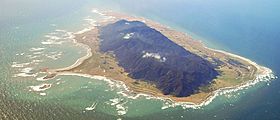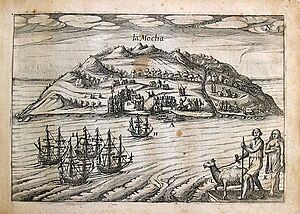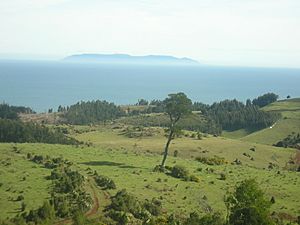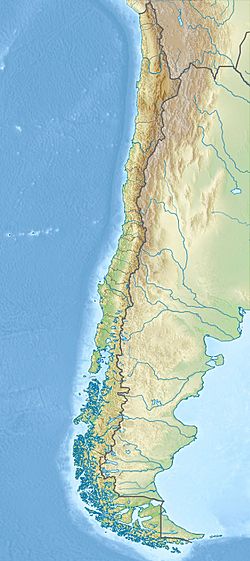Mocha Island facts for kids
|
Native name:
Isla Mocha
|
|
|---|---|

Aerial view of Mocha Island
|
|
| Geography | |
| Location | South-central Chile |
| Coordinates | 38°21′54″S 73°54′54″W / 38.36500°S 73.91500°W |
| Area | 48 km2 (19 sq mi) |
| Highest elevation | 300 m (1,000 ft) |
| Administration | |
| Region | Bío Bío |
| Province | Arauco |
| Comuna | Lebu |
| Demographics | |
| Population | ~800 |
| Ethnic groups | Chileans, Mapuches |
Mocha Island (called Isla Mocha in Spanish) is a small island in Chile. It is located in the Pacific Ocean, west of the Arauco Province. The island is about 48 square kilometers (18.5 square miles) in size. It has a small chain of mountains that run from north to south.
In the old stories of the Mapuche people, this island is a special place. They believed that the spirits of people who had passed away would travel west to visit Mocha Island. Today, a large part of the island (about 45%) is a protected area called the Mocha Island National Reserve. The waters around the island are also famous for fishing. Many old shipwrecks have been found near its shores.
Contents
Amazing Animals on Mocha Island
The Pacific degu (Octodon pacificus) is a special type of rodent. It is also known as the Mocha Island degu. This animal lives only on Mocha Island and nowhere else in the world!
Island Geology: How Mocha Island Was Formed
Mocha Island is made of sedimentary rock. These rocks are part of a larger rock formation found on the mainland. In 2010, a big earthquake caused the island to lift up a little. However, it lifted less than the nearby coast. Scientists think this might be because of a special splay fault called the Tirúa-Mocha Fault.
Mocha Island's Exciting History

For a long time, the island was home to the Lafkenches. They were a group of Mapuche people who lived by the coast. The first European to write about Mocha Island was Juan Bautista Pastene. He saw it on September 10, 1544, and named it Isla de San Nicolas de Tolentino.
In 1614, a Dutch captain named Joris van Spilbergen visited the island. He saw something amazing: the native Mapuche people were using animals called chilihueques to help them plough their fields. Chilihueques are a type of South American camelid, similar to llamas.
Pirates and Explorers Visit Mocha Island
Mocha Island was a popular stop for pirates and privateers from the Netherlands and England. Famous explorers like Francis Drake and Olivier van Noort used the island to get supplies. When Drake visited during his trip around the world, he was seriously hurt by the Mapuche people living there. Drake's cousin, Richard Hawkins, also sailed past the island on his ship, the Dainty.
Eventually, in 1685, the Mapuche people on Mocha Island were moved. Governor José de Garro transported them to a new settlement. This new place was on the banks of the Biobío River. It later grew into the modern city of Concepción, Chile.
Mocha Dick: The Famous White Whale
The waters around Mocha Island were also home to a very famous sperm whale in the 1800s. This whale was known as Mocha Dick. An American explorer named Jeremiah N. Reynolds wrote a story about it in 1839. His story, "Mocha Dick: Or The White Whale of the Pacific," was published in a magazine. Mocha Dick later helped inspire the famous fictional whale, Moby Dick. This character appeared in the 1851 novel Moby-Dick by Herman Melville.

Could Polynesians Have Visited Mocha Island?
In December 2007, something very interesting was found in a museum in Concepción. Several human skulls were discovered that looked like they belonged to people from Polynesia. These skulls had a special shape when viewed from behind. They had come from Mocha Island. This discovery makes some people wonder if Polynesians might have visited Mocha Island a very long time ago!
See also
 In Spanish: Isla Mocha para niños
In Spanish: Isla Mocha para niños


